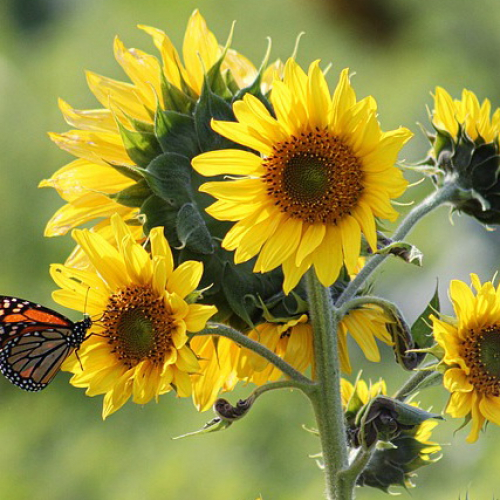Perennials Sunflower

Description
Characteristic Features of Sunflower
Sunflower (Helianthus) is a genus of annual and perennial plants in the family Asteraceae or Compositae. These stately plants turning their heads to face the sun are native to North America; some species are cultivated everywhere around the world. The Indians viewed Sunflower as a symbol of the deity of the Sun, and in the south of North America, Sunflower was worshipped as a sacred plant.
Growing in the wild, Sunflower can reach a height of 5 metres, while cultivated species are typically somewhat lower. The root system is strong. The taproot penetrates the soil to the depth of 2 metres and lateral roots spread to 1 metre apart. The stem is stout, erect, and covered with hairs. The leaves are rough, toothed at the edges, and covered with hairs. The inflorescence is a disc-shaped basket with numerous yellow brown tubular and ray florets surrounded by small green leaves. Flowering begins in late summer.
The fruit is an achene consisting of the pericarp (the hull) and the kernel (white seeds). Depending on the variety, the hull may be of different colours: white, striped, brown, or black. 100 grams of roast seeds contain about 21 grams of protein, 3 grams of carbohydrates, and 53 grams of fat. In addition, they contain vitamins PP and E, as well as polyunsaturated fatty acids, phospholipids, lecithin, and vegetable waxes.
The genus Helianthus is very diverse and comprises over 100 species. It includes not only ornamental plants, such as Purpledisk Sunflower (Helianthus atrorubens), Thinleaf Sunflower (Helianthus decapetalus), Silverleaf Sunflower (Helianthus argophyllus), Giant Sunflower (Helianthus giganteus), Cheerful Sunflower or Mountain Sunflower (Helianthus laetiflorus), Cucumberleaf Sunflower (Helianthus cuccumerifoliius), but also the species grown primarily as edible crops, such as Jerusalem Artichoke or Topinambur (Helianthus tuberosus), a perennial with valuable root vegetables, or Common Sunflower (Helianthus annuus) grown to produce sunflower oil for culinary and industrial applications, reaching a height of 3 metres and having a thick simple or branched stem and inflorescences about 20 centimetres across with orange and yellow petals. Thanks to successful breeding, currently there are varieties with a lower stem and flowers that are more attractive.
Ornamental Sunflower species look great in ridges, mixed borders, and flower beds combined with high herbaceous plants, as well as along fences and buildings.
Low-growing varieties can be grown in containers. For example, 'Teddy Bear' is often used to decorate balconies and porches. Sunflower is good for cutting and has a vase life of least two weeks. Sunflower oil is very popular and healthy. Leaf, root, and flower decoctions and infusions help to treat various diseases, that is why this solar plant has long earned a good reputation in alternative medicine.
The Secrets to Successfully Growing Sunflower
All species of Sunflower are very light-requiring; annuals are frost-tender and require good care. Sunflower thrives in fertile soils (loam or loamy black soil) with neutral acidity. Choose windless locations as the tall stem can be broken by gusty winds.
The basic care involves loosening the soil, staking weak stems, feeding with compound fertilizers in the autumn and early summer, deadheading spent flowers, and winter sheltering with spruce branches or a layer of dry leaves. Sunflower should be watered infrequently, only as necessary. Water regularly only during pricking out young plants, inflorescence formation, and beginning of blooming.
Transplant perennial Sunflowers every 6-7 years. Propagate by division in early spring or autumn.
Annual species are propagated by seed sown out directly in the garden in May, when the soil warms up to 10 ° C. Sow 2-3 seeds in one hole 3-5 centimetres deep and 30-40 centimetres apart. After germination, thin out, weed, and apply mineral and organic fertilizers. You can also sow the seeds indoors. Make sure the young plant get enough light.
Potential Problems
Sunflower may get white mold (Sclerotinia sclerotiorum) and grey mold (Botrytis cinerea). More often, these diseases affect basal parts and flower baskets, causing grey rotting spots.
Other frequent diseases are:
Phomopsis (pathogen Diaporthe helianthi): grey-brown spots appear on the stems, leaves and flowers; the stem becomes completely grey and can be easily broken.
Sunflower gangrène (pathogen Phoma oleraceae): brown spots appear on the stem and inflorescences.
Downy mildew (pathogen Plasmopara helianthi): white-grey coating appears on the shoots, stunting the growth.
Leaf spot (pathogen Septoria helianthi): brown spots.
Rust (pathogen Puccinia helianthi): red spots.
Verticillium (pathogen Verticillium dahliae): brown spots with yellow border.
Early blight (pathogen Alternaria helianthi): brown spots appear on the inflorescences and leaves.
At the first sign of the disease, remove and burn affected plants and spray the remaining Sunflowers with fungicides.
The most dangerous pest for Sunflower is the sunflower moth that damages achenes. Choose pest-resistant varieties, otherwise you may lose the crop. Other pests, such as sunflower barbells, grey and black beet weevils, alfalfa and cotton cutworms, wireworms, herbivorous bugs, helichrysum aphids, meadow moths, and tumbling sunflower beetles eat parts of the plant and do not allow it to grow. Even if no sign of infestation is detected, spray Sunflower with insecticides for prevention.
The root system can be affected by a parasitic weed called the sunflower broomrape (Orobanche cumana), a low-growing blue-flowered plant. As prevention, regularly weed and change the location every 7 years.







 334
334








